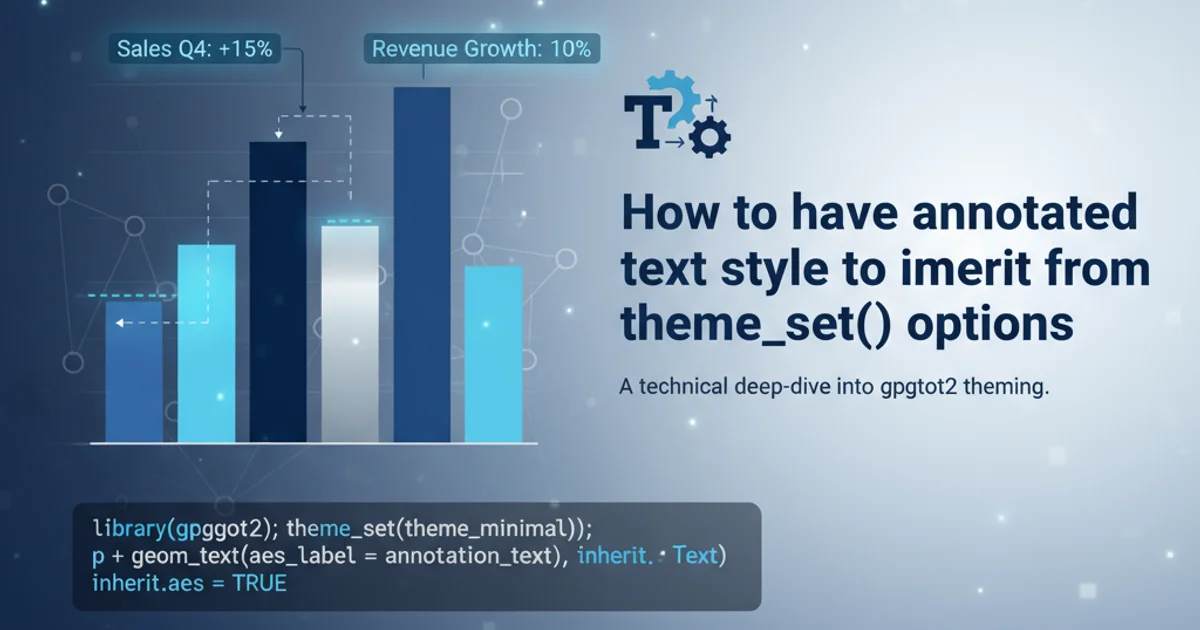How to have annotated text style to inherit from theme_set() options
Categories:
Inheriting Annotated Text Styles in ggplot2 from theme_set() Options

Learn how to ensure your annotate() text elements in ggplot2 automatically adopt the styling defined by your global theme_set() options, maintaining consistent plot aesthetics.
When creating visualizations with ggplot2 in R, theme_set() is a powerful function for establishing global aesthetic defaults. This ensures consistency across multiple plots without repeatedly specifying theme elements. However, a common challenge arises when using annotate() to add text labels to a plot: these annotations often do not automatically inherit the text styles (like font family, size, or color) defined in theme_set(). This article will guide you through understanding why this happens and provide effective solutions to make your annotated text seamlessly integrate with your chosen theme.
Understanding the Disconnect: annotate() vs. theme_set()
The annotate() function in ggplot2 is designed for adding static, non-data-mapped graphical elements to a plot. While it allows direct specification of aesthetic parameters (e.g., size, color, family), it does not inherently 'know' about the global theme settings established by theme_set(). Theme elements, such as text or plot.title, are typically applied to data-driven text elements (like axis labels, titles, legends) or specific plot components. annotate() operates at a lower level, requiring explicit aesthetic mapping or manual inheritance.
flowchart TD
A[theme_set() Global Theme] --> B{ggplot() Plot Object}
B --> C[Data-driven Text Elements (e.g., axis.text, plot.title)]
C -- Applies Theme --> D[Styled Text]
B --> E[annotate() Call]
E -- Does NOT Inherit Directly --> F[Unstyled Annotated Text]
F -- Requires Manual Intervention --> DFlowchart illustrating the inheritance path of theme settings in ggplot2
Solution 1: Explicitly Referencing Theme Elements
The most direct way to make annotate() text inherit theme properties is to explicitly extract those properties from the active theme and pass them to annotate(). This involves using theme_get() to retrieve the current theme and then accessing specific elements. This method offers precise control and ensures that your annotations always match the current global theme.
library(ggplot2)
# 1. Set a global theme
theme_set(theme_minimal() +
theme(text = element_text(family = "serif", size = 14, color = "darkblue"),
plot.title = element_text(face = "bold", size = 16)))
# 2. Create a base plot
p <- ggplot(mtcars, aes(mpg, hp)) +
geom_point() +
labs(title = "Car Performance")
# 3. Get the current theme
current_theme <- theme_get()
# 4. Extract text element properties
text_element <- current_theme$text
# 5. Use properties in annotate()
p + annotate("text", x = 20, y = 200, label = "Annotated Text",
family = text_element$family,
size = text_element$size / .pt, # Convert mm to points
color = text_element$colour) +
theme(plot.title = element_text(family = text_element$family, size = text_element$size, color = text_element$colour))
Explicitly referencing theme elements for annotate() text styling.
element_text's size parameter is in millimeters, while annotate()'s size is in points. You need to divide by .pt (a constant from ggplot2 representing points per mm) to convert correctly.Solution 2: Creating a Helper Function for Annotated Text
For more complex plots or frequent use of annotated text, creating a helper function can streamline the process. This function can encapsulate the logic of retrieving theme elements and applying them to annotate(), making your code cleaner and more reusable.
library(ggplot2)
# Set a global theme
theme_set(theme_bw() +
theme(text = element_text(family = "sans", size = 12, color = "gray30"),
plot.title = element_text(face = "italic", size = 18, color = "darkgreen")))
# Helper function to get theme text properties for annotate()
annotate_themed_text <- function(x, y, label, ...){
current_theme <- theme_get()
text_element <- current_theme$text
annotate("text", x = x, y = y, label = label,
family = text_element$family,
size = text_element$size / .pt,
color = text_element$colour,
...)
}
# Use the helper function
p <- ggplot(iris, aes(Sepal.Length, Petal.Length, color = Species)) +
geom_point() +
labs(title = "Iris Flower Dimensions")
p + annotate_themed_text(x = 6, y = 2, label = "Data Annotation")
Using a helper function to apply theme text styles to annotate().
Solution 3: Modifying the Theme for annotate() (Advanced)
While annotate() doesn't directly inherit from theme_set(), you can define a custom theme element that annotate() can then reference. This is a more advanced approach and might be overkill for simple cases, but it offers a way to centralize annotate() specific styles within your theme definition.
library(ggplot2)
# Define a custom theme element for annotations
my_theme_annotations <- theme(
annotate.text = element_text(family = "mono", size = 10, color = "purple", face = "italic")
)
# Set the global theme including the custom annotation element
theme_set(theme_classic() +
theme(text = element_text(family = "serif", size = 14, color = "darkblue"),
plot.title = element_text(face = "bold", size = 16)) +
my_theme_annotations)
# Retrieve the custom annotation element
annotation_text_element <- theme_get()$annotate.text
# Use it in annotate()
p <- ggplot(data.frame(x=1:10, y=1:10), aes(x,y)) +
geom_line() +
labs(title = "Custom Annotation Theme")
p + annotate("text", x = 5, y = 5, label = "Custom Themed Annotation",
family = annotation_text_element$family,
size = annotation_text_element$size / .pt,
color = annotation_text_element$colour,
fontface = annotation_text_element$face)
Defining and using a custom theme element for annotate().
annotate.text is not a standard ggplot2 theme element. You must manually retrieve and apply it, similar to Solution 1, but it centralizes the definition within your theme.By implementing these strategies, you can ensure that all text elements in your ggplot2 visualizations, including those added with annotate(), maintain a consistent and professional appearance dictated by your theme_set() options. This leads to more polished and aesthetically pleasing plots that adhere to your desired visual style.